Bidú Sayão
muzicafe :: KLASİK MÜZİK :: OPERA :: EFSANE SOPRANOLAR
1 sayfadaki 1 sayfası
 Bidú Sayão
Bidú Sayão
Bidú Sayão
From Wikipedia, the free encyclopediaJump to: navigation, search
Bidú Sayão (May 11, 1902 – March 12, 1999 was a Brazilian opera soprano. One of Brazil's most famous musicians, Sayão was a leading artist of the Metropolitan Opera in New York City from 1937 to 1952.
Life and career
Bidú Sayão was born Balduína de Oliveira Sayão to a cultured family in Botafogo, Rio de Janeiro. Her father died when she was five years old and her mother struggled to support her daughter's costly pursuit of a singing career. At the age of only eighteen, the gifted Bidú Sayão made her major opera debut in Rio de Janeiro. Her acclaimed performance led to an opportunity to study with the famous Elena Teodorini, first in Brazil and then in Romania; and then to study with the renowned Polish tenor and tutor, Jean de Reszke, in Nice. During the mid 1920s and early 1930s, she performed in Rome, Buenos Aires, Paris, as well as in her native Brazil. While at the Teatro Costanzi in Rome, she met impresario Walter Mocchi (1870–1955). After his wife, soprano Emma Carelli, died in 1928, the two became romantically involved and were married. However, it did not last and in 1935 Sayão married the Italian baritone, Giuseppe Danise (1883–1963).
In 1930, she debuted at the Teatro alla Scala in Milan, and in the next year she sang a successful Juliette, in Gounod's Roméo et Juliette, at the Paris Opera. In the same year, she gained a great success with her debut at the Opéra Comique as Lakmé. She soon became one of the leading lyric coloratura sopranos in Europe, especially in Italy and France. Her repertoire included Lucia di Lammermoor, Amina in La sonnambula, Elvira in I puritani, Zerbinetta in Ariadne auf Naxos and Cecilia in Il Guarany, among other roles.
A star at the Metropolitan Opera
Bidú Sayão made her U.S. debut in a recital at Town Hall in New York City on December 30, 1935. Her U.S. operatic debut followed not long thereafter, on January 21, 1936, when she and Danise sang in the penultimate production of the Washington National Opera, a semi-professional company not associated with its modern namesake; the performance, of Léo Delibes's Lakmé, was marred by a fractious dispute in which the orchestra musicians declined to play without payment in cash, and ultimately the performance was accompanied by a portable organ, with some singers appearing in costume and some in street clothes owing to a similar demand by the stage hands and costume man. Altogether more dignified was her performance a few months later with the New York Philharmonic at Carnegie Hall singing La Demoiselle élue by Debussy. Her performance was under the baton of Arturo Toscanini, who would become her greatest supporter and lifelong friend. She sang her first performance at the Metropolitan Opera as Manon on February 13, 1937, replacing the Spanish soprano Lucrezia Bori. The critics, including Olin Downes of the New York Times, raved about her performance and within a few weeks she was given the lead in La traviata, followed soon thereafter by Mimì in La bohème. She also contributed to the Mozart revival at the Metropolitan Opera, becoming the pre-eminent Zerlina (Don Giovanni) and Susanna (The Marriage of Figaro) of her generation.
As the favorite singer of Brazilian composer Heitor Villa-Lobos, she had an artistic partnership with him that lasted many years and made a number of recordings of his compositions, including a famous recording of the Bachianas Brasileiras No. 5.
Bidú Sayão and her husband Giuseppe Danise purchased an oceanfront property in Lincolnville, Maine. After fifteen years with the Metropolitan Opera, she gave her last performance in 1952, choosing to retire from opera while still at the top of her form. For the next two years she was a guest performer throughout the U.S., but in 1957 she decided to retire completely from public performance; two years after that she made her final recording as the soprano soloist on Villa-Lobos's world premiere stereo recording of his cantata Forest of the Amazon with the composer conducting the Symphony of the Air.
Following the death of her husband in 1963, Bidú Sayão lived a quiet life at her home in Maine. She returned to visit Brazil a last time in 1995, for a tribute to her during the Carnival in Rio de Janeiro, and died a few years later at the Penobscot Bay Medical Center in Rockport, Maine. Her ashes were scattered across the bay in front of her home.
Although Brazilians have always been strong patrons of the opera, at the time Bidú Sayão was struggling to launch her career there was little in the way of government assistance for aspiring singers; throughout her life she spoke about this lack of support. Following her last visit to her homeland, the government prepared plans to honor her memory. In 2000 the Bidu Sayão International Vocal Competition was established to promote Brazilian operatic talent through a world-class competition.
Bidú Sayão's portrait hangs in the lobby at the Metropolitan Opera House in New York City.
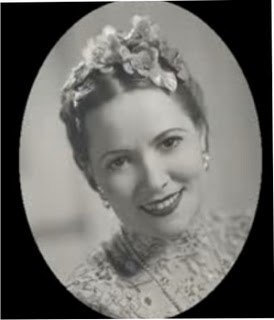







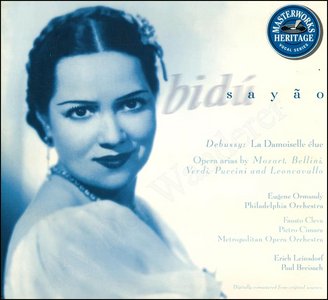
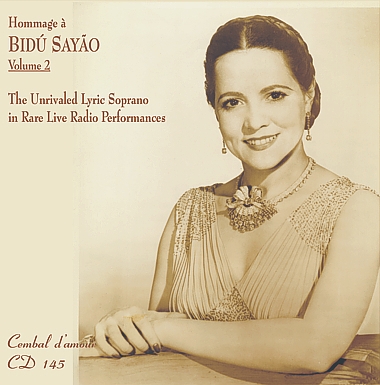
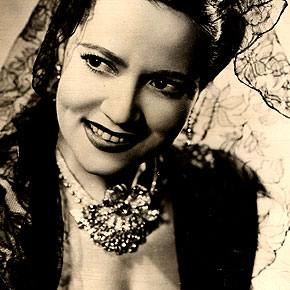





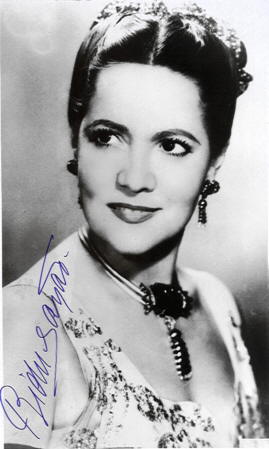
From Wikipedia, the free encyclopediaJump to: navigation, search
Bidú Sayão (May 11, 1902 – March 12, 1999 was a Brazilian opera soprano. One of Brazil's most famous musicians, Sayão was a leading artist of the Metropolitan Opera in New York City from 1937 to 1952.
Life and career
Bidú Sayão was born Balduína de Oliveira Sayão to a cultured family in Botafogo, Rio de Janeiro. Her father died when she was five years old and her mother struggled to support her daughter's costly pursuit of a singing career. At the age of only eighteen, the gifted Bidú Sayão made her major opera debut in Rio de Janeiro. Her acclaimed performance led to an opportunity to study with the famous Elena Teodorini, first in Brazil and then in Romania; and then to study with the renowned Polish tenor and tutor, Jean de Reszke, in Nice. During the mid 1920s and early 1930s, she performed in Rome, Buenos Aires, Paris, as well as in her native Brazil. While at the Teatro Costanzi in Rome, she met impresario Walter Mocchi (1870–1955). After his wife, soprano Emma Carelli, died in 1928, the two became romantically involved and were married. However, it did not last and in 1935 Sayão married the Italian baritone, Giuseppe Danise (1883–1963).
In 1930, she debuted at the Teatro alla Scala in Milan, and in the next year she sang a successful Juliette, in Gounod's Roméo et Juliette, at the Paris Opera. In the same year, she gained a great success with her debut at the Opéra Comique as Lakmé. She soon became one of the leading lyric coloratura sopranos in Europe, especially in Italy and France. Her repertoire included Lucia di Lammermoor, Amina in La sonnambula, Elvira in I puritani, Zerbinetta in Ariadne auf Naxos and Cecilia in Il Guarany, among other roles.
A star at the Metropolitan Opera
Bidú Sayão made her U.S. debut in a recital at Town Hall in New York City on December 30, 1935. Her U.S. operatic debut followed not long thereafter, on January 21, 1936, when she and Danise sang in the penultimate production of the Washington National Opera, a semi-professional company not associated with its modern namesake; the performance, of Léo Delibes's Lakmé, was marred by a fractious dispute in which the orchestra musicians declined to play without payment in cash, and ultimately the performance was accompanied by a portable organ, with some singers appearing in costume and some in street clothes owing to a similar demand by the stage hands and costume man. Altogether more dignified was her performance a few months later with the New York Philharmonic at Carnegie Hall singing La Demoiselle élue by Debussy. Her performance was under the baton of Arturo Toscanini, who would become her greatest supporter and lifelong friend. She sang her first performance at the Metropolitan Opera as Manon on February 13, 1937, replacing the Spanish soprano Lucrezia Bori. The critics, including Olin Downes of the New York Times, raved about her performance and within a few weeks she was given the lead in La traviata, followed soon thereafter by Mimì in La bohème. She also contributed to the Mozart revival at the Metropolitan Opera, becoming the pre-eminent Zerlina (Don Giovanni) and Susanna (The Marriage of Figaro) of her generation.
As the favorite singer of Brazilian composer Heitor Villa-Lobos, she had an artistic partnership with him that lasted many years and made a number of recordings of his compositions, including a famous recording of the Bachianas Brasileiras No. 5.
Bidú Sayão and her husband Giuseppe Danise purchased an oceanfront property in Lincolnville, Maine. After fifteen years with the Metropolitan Opera, she gave her last performance in 1952, choosing to retire from opera while still at the top of her form. For the next two years she was a guest performer throughout the U.S., but in 1957 she decided to retire completely from public performance; two years after that she made her final recording as the soprano soloist on Villa-Lobos's world premiere stereo recording of his cantata Forest of the Amazon with the composer conducting the Symphony of the Air.
Following the death of her husband in 1963, Bidú Sayão lived a quiet life at her home in Maine. She returned to visit Brazil a last time in 1995, for a tribute to her during the Carnival in Rio de Janeiro, and died a few years later at the Penobscot Bay Medical Center in Rockport, Maine. Her ashes were scattered across the bay in front of her home.
Although Brazilians have always been strong patrons of the opera, at the time Bidú Sayão was struggling to launch her career there was little in the way of government assistance for aspiring singers; throughout her life she spoke about this lack of support. Following her last visit to her homeland, the government prepared plans to honor her memory. In 2000 the Bidu Sayão International Vocal Competition was established to promote Brazilian operatic talent through a world-class competition.
Bidú Sayão's portrait hangs in the lobby at the Metropolitan Opera House in New York City.

















muzicafe :: KLASİK MÜZİK :: OPERA :: EFSANE SOPRANOLAR
1 sayfadaki 1 sayfası
Bu forumun müsaadesi var:
Bu forumdaki mesajlara cevap veremezsiniz